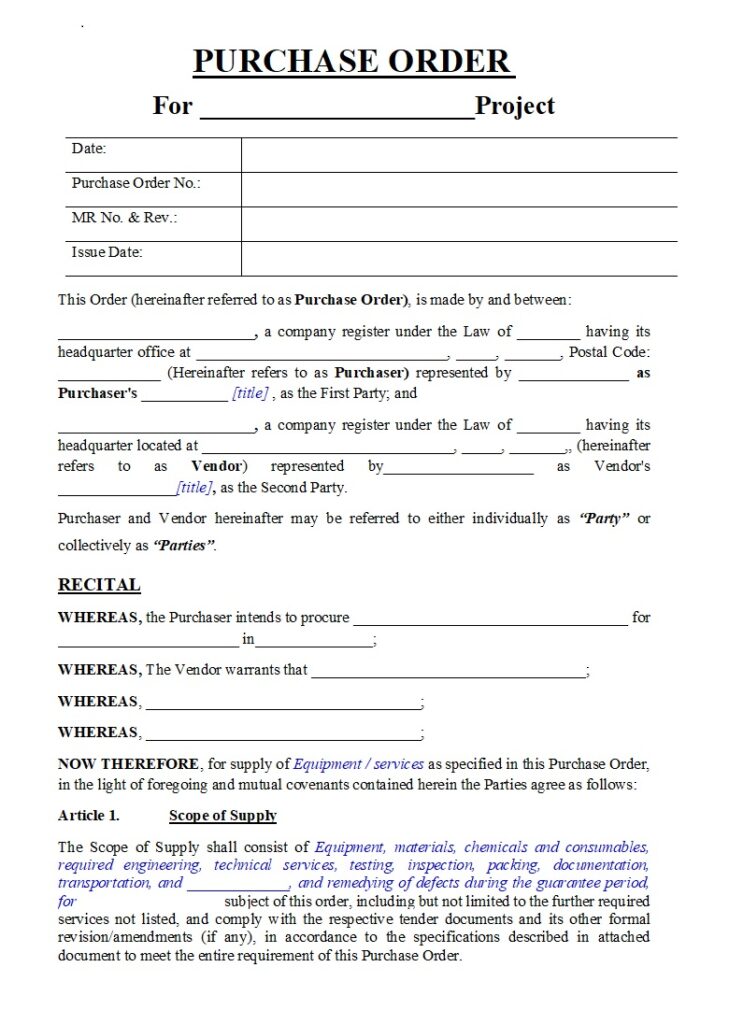Estimated reading time: 4 minutes
A Purchase Order (For Procurement of Projects’ Equipment and Materials) is the formal document that authorises the procurement of equipment and materials for a defined project. It sets out the agreed requirements between the purchaser and the supplier. Each order confirms product specifications, quantities, prices, and delivery obligations, ensuring that both parties act under precise and enforceable terms. Within a project, it operates as a binding supplement to the main contract, controlling every acquisition made for execution.
Purpose and Function
A Project Purchase Order establishes contractual clarity. It translates project needs into measurable supply actions. By describing all deliverables, it prevents disputes over quality or delivery. The document provides a reliable record of what the project will purchase, how much it will pay, and when it expects delivery. It also supports budget tracking, audit compliance, and procurement transparency throughout the project life cycle.

Core Structure
Every Project Purchase Order contains precise information to avoid ambiguity. First, it identifies the purchaser, the supplier, and the project. Then, it includes an order number, date, and approval details. Next, it lists the description of goods, specifications, standards, and certifications. Each item defines its quantity, measurement unit, unit price, and total value. After that, the document sets the delivery place, period, and shipping method.
Additionally, it defines packing, marking, and documentation rules. The payment section follows, stating the method, currency, and timing. It also explains warranty, inspection, and insurance conditions. Finally, it ends with governing law, contractual reference, and the supplier’s acceptance, turning it into a binding agreement.
Process and Implementation
The Project Purchase Order process begins once the project team identifies a need for equipment or materials. After internal verification, a purchase requisition is raised. Subsequently, the procurement department evaluates suppliers and negotiates terms. Once approved, the Purchase Order is issued to the chosen supplier. Upon acknowledgment, it becomes legally effective. During execution, the supplier prepares, ships, and delivers the goods.
Meanwhile, the site team inspects and records delivery to confirm compliance. If any discrepancy appears, a change order is issued. After acceptance, the supplier submits the invoice, and payment is made according to the defined schedule. Ultimately, the order closes when all conditions are fulfilled and documented.
Project Integration
Within major projects, several Purchase Orders may operate simultaneously. Each order covers a specific supply package, ensuring smooth coordination across multiple vendors. Because each Project Purchase Order has a defined cost code, it integrates directly with the project’s budget system. Moreover, procurement progress is linked with schedule milestones, allowing managers to monitor both cost and delivery. Therefore, the timely and structured issuance of Purchase Orders supports balanced cash flow and accurate forecasting. In addition, the standard format ensures consistency across the entire supply chain, strengthening both project control and documentation.
Compliance and Governance
A Project Purchase Order supports contractual compliance. It ensures that suppliers deliver within the standards set by the project specifications and regulatory codes. Proper documentation—such as inspection reports, certificates of conformity, and packing lists—must accompany each delivery. The order must refer to governing law and dispute resolution procedures consistent with the main contract.
Any amendment requires written approval from both parties to maintain contractual integrity. When all orders follow a standard format and approval process, the project maintains a consistent legal and commercial position with every supplier.
Benefits of an Effective Purchase Order System
An effective system improves accuracy, accountability, and cost control. It provides real-time visibility of commitments and expenditures. It reduces procurement cycle time, secures supplier performance, and supports timely project completion. It also protects the purchaser by defining exact remedies for late or defective delivery. Through structured documentation, the organisation preserves a complete audit trail, strengthening both internal governance and external compliance.
Conclusion
The Project Purchase Order is more than a supply document. It is a control mechanism that binds commercial, technical, and legal dimensions of procurement. When managed correctly, it guarantees that equipment and materials reach the project site in the right quality, quantity, and time, under terms consistent with the contract. Its precision safeguards the project’s financial and operational success.
Check out more pages of our website for related content:
- Purchase Order (Terms and Conditions)
- Purchase Order (simple format)
- Performance Bank Guarantee – PBG (for Supply Equipment and
- Used Equipment Purchase & Sale Agreement
- Supply Agreement
- Project Purchase Order
Access the Full Contract Directory
You can browse the complete alphabetical list of all commercial, financial, and project-based contract templates by visiting our A–Z Contract Index.
References
- International Federation of Consulting Engineers (FIDIC). Procurement Procedures for Projects, Geneva, 2021.
- Purchase orders for a project
has been added to your cart!
have been added to your cart!



